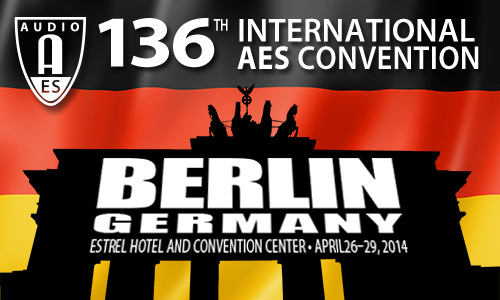
AES Berlin 2014
Engineering Brief EB1
EB1 - Poster Session 1
Saturday, April 26, 15:00 — 16:30 (Foyer)
EB1-1 Remixing a Historic Film in Higher Order Ambisonics 3-D Audio—Workflow and Technical Solutions—Tobias Falke, Hamburg University of Applied Sciences - Hamburg, Germany; Johann-Markus Batke, Audio & Acoustics, Technicolor Research & Innovation - Hannover, Germany; Thomas Görne, Hamburg University of Applied Sciences - Hamburg, Germany
The project investigates the suitability of Higher Order Ambisonics (HOA) 3-D audio for the redesign and remix of historic film soundtracks. Technical and aesthetic challenges and hurdles are studied with scenes of a 1953 french classic. In order to obtain a high degree of immersion and on the other hand also to fix technical limitations of the historical material, some parts of the soundtrack were redesigned. The resulting HOA 3-D mix is claimed to be format agnostic, i.e., it is designed to be used on all common 3-D and also 2-D loudspeaker layouts, given the appropriate rendering system is provided.
Engineering Brief 130 (Download now)
EB1-2 Moving the Room... Acoustics, Around the Beamformer Beam—Georgios Flamis, Dialog Semiconductor - Patras, Greece; Maria Platypodi, Dialog Semiconductor - Patras, Achaia, Greece
As the demand for audio beamforming to commercial applications is increasing, the need for a robust evaluation method becomes apparent. In such applications, the beam is shaped by the microphone distribution and the directional response that the algorithm calculates. Thus, it will be located to the 3-D space with predefined acceptance angle. The performance of the beamforming system over the scenarios of noise reduction and echo control can be estimated once the beam location is properly defined. Presented are the methods of equalizing the sound production of background noise into the room acoustics, as well as the resulting conditions, under which the edges of the beam can be definable.
Engineering Brief 131 (Download now)
EB1-3 Spatial Sound for Mobile Navigation Systems—Wataru Sanuki, University of Aizu - Aizu, Japan; Julian Villegas, University of Aizu - Aizu Wakamatsu, Fukushima, Japan; Michael Cohen, University of Aizu - Aizu Wakamatsu-shi, Fukashima-ken, Japan
We have developed a mobile navigation system featuring binaural spatial sound delivered via headphones. “Machi-beacon” is intended to promote traffic and pedestrian safety: users select a destination relative to their current position, and the application renders both a visual map and an auditory earcon at the goal. The apparent location of this earcon is adjusted to reflect changes in orientation of the user by modulations of the interaural level difference. To disambiguate front and back directions, the earcon progressively changes between contrasting cues. By desaturating the visual modality, smartphone users can focus on their environment and its hazards and rewards.
Engineering Brief 132 (Download now)
EB1-4 Two Dimensional Gestural Control of Audio Processing—Tom Wilson, University of Huddersfield - Huddersfield, West Yorkshire, UK; Steven Fenton, University of Huddersfield - Huddersfield, West Yorkshire, UK
This project investigates the design of a 2-D, single, and multi-touch gesture set for the control of audio processing
commonly found within DAWS and mixing consoles. The recent popularity of touch pads has made wider application in this area possible. We describe the testing, analysis, and mapping of gestures to theorize the most efficient control over audio processing parameters. By improving the control interface, workflow efficiency could be greatly improved. A test was carried out that observed engineers as they carried out specific mixing tasks using standard Pro Tools plug-ins. In addition, a survey was constructed to determine the most popular gestures for common processing parameters. The workflow and recorded gestures were then analyzed and a set of optimized gesture based controls were produced.
Engineering Brief 133 (Download now)
EB1-5 Influence of Directional Differences of First Reflections in Small Spaces on Perceived Clarity—Hidetaka Imamura, Tokyo University of the Arts - Tokyo, Japan; Atsushi Marui, Tokyo University of the Arts - Adachi-ku, Tokyo, Japan; Toru Kamekawa, Tokyo University of the Arts - Adachi-ku, Tokyo, Japan; Masataka Nakahara, SONA Corp. - Tokyo, Japan
The ultimate goal of the research is to propose an acoustic measure of perceived clarity for small spaces such as studio control rooms and listening rooms. While C80 is somewhat successful in predicting the perceived clarity of sound in performance spaces, detailed research of clarity in small spaces has not been conducted. An experiment was conducted to investigate the perceived clarity of reproduced sound in small spaces with a focus on the arrival direction and delay time of the first reflections. Seven participants were asked to evaluate the sounds with loudspeaker simulated wall reflections in author-constructed temporal quasi-anechoic chamber. Variation of the first reflections did significantly influence perceived clarity and spatial impressions such as ASW, LEV, and spatial definition.
Engineering Brief 134 (Download now)
EB1-6 Multidimensional Ability Evaluation of Participants of Listening Tests—Tomasz Dziedzic, AGH University of Science and Technology - Krakow, Poland; Piotr Kleczkowski, AGH University of Science and Technology - Krakow, Poland
In this e-Brief, the problem of selecting proper participants for a listening test will be addressed. The authors will describe the idea of multidimensional ability evaluation of participants and present an initial version of application developed to perform preliminary ability evaluation tests. The software testing results and conclusions as well as a draft for future work are presented.
Engineering Brief 135 (Download now)
